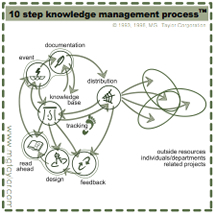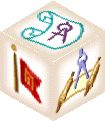| The use of the term architecture to describe a structure outside of the field of architecture has become a much abused habit. In this case, there is merit in the attribution. The Solution Box is an architecture of specific stages and steps which creates a matrix of 343 cells that are way points along the path an idea takes from concept to realization and use. The Solution Box allows you to know where you are in the creative process and it establishes performance specifications for the form a work must take, and the veracity of content it must have, at each major point of social interaction, contracting and use. |
| This commentary will provide a general introduction to the Solution Box and its uses while also serving as an Index to a series of pages which take the Solution Box apart to explicate its inner structure and establish the nature and criteria of completeness for each of its cells. |
|
 |
The Solution Box has a close companion which is the !0 Step Process. The Solution Box describes the what and establishes standards: how you know where you are and what you should have for where you are. The 10 Step Process is the knowledge engine that gets you there and communicates status.
click on the graphic for more and link: 10 Step Process |
|
| The Solution Box is made up of three models which are key components of the MG Taylor Modeling Language [link: mg taylor modeling language]. One is the Creative Process delineated in 7 steps. The second, the Vantage Points Model which we adapted from Gilbert’s work. The third, the Design Formation Model which describes the idea development process and the form ideas take. This model was derived from architecture, engineering, building and manufacturing practices. |
| The three provide an interactive matrix of process, viewpoint, and the form the work is rendered in. Each intersection - or cell - has its own language, standard of completion, criteria of veracity and utility. A Solution Box designation on a document - like I employ at the bottom of these web pages - tells the document user the degree of completion, the “voice” and the viewpoint by which the document was created; thus, the intent for how it should be understood and used. This is information about the information, sometime referred to as meta-data, which is being presented. lacking this, you do not know how to understand, judge and use the material. You can only guess. This can lead to serious misunderstandings as well as costly errors. |
| If I were to give you a drawing and description for a peice of furniture and draw it acurately and to scale, how would you “take” the idea? Suppose I was here: |
| |
|
I am about 25 percent through the process. I have an INSIGHT about the design, I am communicating the PHILOSOPHY of the work to you and I have taken its expression to the SCHEMATIC DESIGN level. In other words, I have a mature idea that I feel is a synthesis of all the challenges inherent in the project, I can talk about it with some clarity and express it as visual solution. I have done a lot of work yet I do not have a build-able design. |
|
|
| |
 |
|
| |
 |
|
| And you thought I was here: |
| |
|
| You think I am through ENGINEERING, and you are expecting a description on the TASK level and the drawings that are ready for issue to facilitate the PROJECT MANAGEMENT process of the work. In other words, you think you have what is necessary to get solid prices and to build something. From your perspective I am about 90 percent finished with the project. This may seem reasonable because the drawings “look” done and I took a long time to produce - as design requires. |
|
|
| |
 |
|
| |
 |
|
| You might want to know the exact cost and how long it will take to build it - which I would not be able to tell you. If you tried to have the design built from what I provided you may find out the furniture shop asking questions that could not be answered and charging extra time to redo work. Soon everybody would be angry at each other and you would think me a very poor designer and tell all your friends never to hire me. I would get upset because you would not want to pay me and the furniture fabricator changed the design in all kinds of ways trying the get it built. The craftsman would be convinced that “crazy” designers, with no practical experience, should be locked up and only tried and true traditional pieces can be build economically, on time and that “experiments” with new ideas are risky. The state-of-the-art is not advancing here. |
| An unlikely story? Far from it. The vast majority of misunderstanding and conflicts stem precisely from this problem and not intrinsic differences. When it is said people are “experienced” working together, this means they have worked their way though these issues and have “learned” each other’s language and processes. Unfortunately, this is usually done in an informal way and every new team, project, or new field of work, cause the struggle to be repeated. Professionals of any given disciple have terms-of-art and this is why. The terms of one field rarely correspond to another - they often contradict each other. Complex projects - and/or new situations - require collaboration across fields, expertise and organizational types - and increasingly today, cultures. Our society has constructed, by fragmented over specialization, a new Tower of Babel. |
| I want to drive this point home. In over 25 years of facilitating organizations of all kinds, including many Fortune 500 corporations, it becomes clear again and again that the majority of conflicts and supposed differences of substance are actually different languages talking past one another. This can be true even with teams who have worked together for a long time. Reflect on this statement. |
| This better way is a practice which utilizes several components of the MG Taylor CyberCon Tool Kit. |
|
| PRACTICE - idea into reality |
|
|
|
|
Matt
Taylor
Nashvillle
September 21, 2002

SolutionBox
voice of this document:
ENGINEER • STRATEGY • CONSTRUCTION DOCUMENT
|
click on graphic for explanation of SolutionBox |
posted:
September 21, 2002
revised:
December 23, 2008
•
20020921.330142.mt • 20061012.768910.mt •
• 20061015.681022.mt • 20081223.340910.mt •
(note:
this document is about 10% finished)
Matt
Taylor 615 720 7390
me@matttaylor.com
Copyright©
Matt Taylor 2002, 2006, 2008
aspects
of this material is
patented and in patent pending |
|
|
|